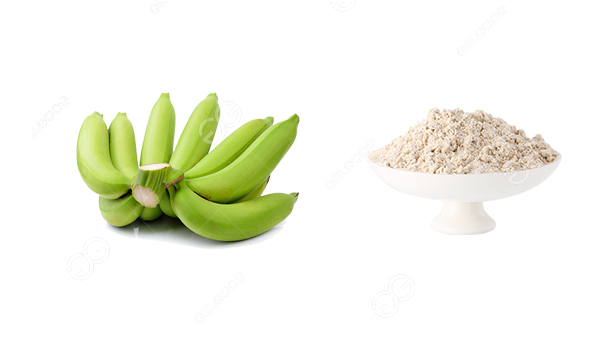Banana flour is a natural and healthy food ingredient that is widely used in a variety of applications such as baby food, health food, baked goods, beverages and flavoring. The banana flour making process is relatively simple, but requires strict quality control and hygiene management to ensure the quality and safety of the final product. The following are the main steps in the making of banana flour:

Step 1. Raw material selection
Fresh and less ripe bananas are selected as raw material. The ripeness of the banana directly affects the quality of the banana flour. The main purpose of this stage is to ensure that the banana has the best flavor and nutritional content.
Step 2. Washing
Selected bananas are washed to remove soil, impurities and pesticide residues from the surface. Washing is usually done under running water and supplemented with food grade sanitizers to ensure the cleanliness and safety of the bananas. After washing, the bananas need to be drained for subsequent processing.
Step 3. Peeling and Slicing
After washing, bananas need to be peeled manually or mechanically to remove the outer skin and bad parts. After peeling, the bananas are cut into uniformly thin slices through a slicing machine. The thickness of the slices is usually 3-5 mm to facilitate the subsequent drying process.
Step 4. Drying
After slicing, banana chips need to be dried. There are various drying methods, such as sun drying, hot air drying and vacuum freeze drying. Although sun drying is low cost, it is easily affected by the weather and hygienic conditions are difficult to control. Hot air drying is the more commonly used method, through the control of temperature and humidity, it can effectively maintain the nutrients and flavor of bananas. Vacuum freeze-drying is more costly, but it can retain the nutrition and flavor of bananas to the greatest extent.
Step 5. Pulverizing and Sieving
The dried banana slice need to be pulverized, usually using a pulverizer to pulverize the banana slice into fine flour. The crushed banana flour needs to be sifted through a sieve to ensure that the fineness of the flour is uniform and meets the requirements of the product specifications.
Step 6. Packaging and Storage
The sieved banana flour needs to be packaged, and the packaging material is usually aluminum foil bag or composite material bag with moisture-proof and oxidation-proof function. Packaging needs to be carried out under aseptic conditions to avoid secondary contamination. Packed banana flour should be stored in a cool, dry and ventilated place, avoiding direct sunlight and high temperature and humid environment to extend its shelf life.
Although the production process of banana flour is simple, each step needs to be strictly controlled to ensure the quality and safety of the final product. Through scientific and reasonable production process, banana flour making equipment and strict quality control, high quality banana flour can be produced to meet the market demand.